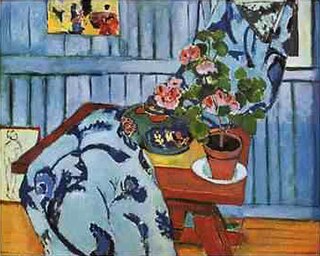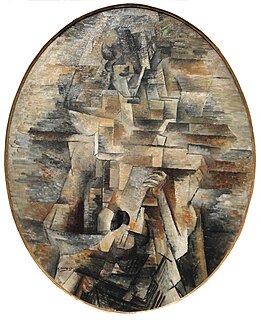 W
WAfter the Bath is a painting from 1910 by the French painter Pierre-Auguste Renoir. The painting is now in the Barnes Foundation in Philadelphia.
 W
WAfternoon Tea is a 1910 oil painting by American artist Richard E. Miller, located in the Indianapolis Museum of Art, which is in Indianapolis, Indiana. Like many of Miller's paintings, it depicts women in a sunny scene, filled with flowers, depicted in his Impressionist style with a distinct flavor of Japonism.
 W
WL'Arbre , is a painting created in 1910 by the French artist, theorist and writer Albert Gleizes. Executed in an advanced Proto-Cubist style, the work was exhibited in Paris at the Salon des Indépendants, 1910, the following year Gleizes chose to exhibit this work at the Salon de la Section d'Or, Galerie La Boétie, 1912, and Manes Moderni Umeni, S.V.U., Vystava, Prague, 1914. The painting was again shown at the Grand Palais, Salon des Indépendants, Trente ans d'art indépendant, in 1926. L'Arbre, an important work of 1910, appeared at the decisive Salon des Indépendants of 1911, where Cubism emerged as a group manifestation and spread across the globe, at times shocking the general public.
 W
WThe Blind Man is a 1910 painting by the Flemish artist Gustave Van de Woestyne, now in the Royal Museum for Fine Arts, Antwerp. It is one of a series of portraits of farm workers he produced in Leuven and shows the influence of what were then called the 'Flemish Primitives', such as Rogier van der Weyden's Portrait of Philip van Croy.
 W
WThe Bush is a painting by Marcel Duchamp from 1910-1911. It is in the collection of the Philadelphia Museum of Art, that acquired it through The Louise and Walter Arensberg Collection in 1950. Its first owner was Dr. Raymond Dumouchel, himself the subject of another 1910 painting by Duchamp, Portrait of Dr. Dumouchel. One of the models may be Jeanne Serre, with whom Duchamp had a relationship and fathered a child, Yvonne, who later became known as Yo Savy. Duchamp noted that the painting marks the beginning of a practice of attaching non-descriptive titles to his work: "Introduce some anecdote without being 'anecdotal'"; the painting did not illustrate a definite theme, but the title created "the possibility to invent a theme for it, afterwards."
 W
WThe City Rises (1910) is a painting by the Italian painter Umberto Boccioni. It was his first major Futurist work.
 W
WDance is a painting made by Henri Matisse in 1910, at the request of Russian businessman and art collector Sergei Shchukin, who bequeathed the large decorative panel to the Hermitage Museum in Saint Petersburg, Russia. The composition of dancing figures is commonly recognized as "a key point of (Matisse's) career and in the development of modern painting". A preliminary version of the work, sketched by Matisse in 1909 as a study for the work, resides at MoMA in New York City, where it has been labeled Dance (I).
 W
WDeux Nus is an early Cubist painting by the French artist and theorist Jean Metzinger. The work was exhibited at the first Cubist manifestation, in Room 41 of the 1911 Salon des Indépendants, Paris. At this exhibition the Cubist movement was effectively launched before the general public by five artists: Metzinger, Gleizes, Le Fauconnier, Delaunay and Léger. This was the first exhibition during which artists, writers, critics and the public at large encountered and spoke about Cubism. The result of the group show is a succès de scandale.
 W
WDogs Playing Poker, by Cassius Marcellus Coolidge, refers collectively to an 1894 painting, a 1903 series of sixteen oil paintings commissioned by Brown & Bigelow to advertise cigars, and a 1910 painting. All eighteen paintings in the overall series feature anthropomorphized dogs, but the eleven in which dogs are seated around a card table have become well known in the United States as examples of kitsch art in home decoration. Depictions and reenactments of the series have appeared in many films, television shows, theater productions, and other popular culture art forms.
 W
WThe Dream is a large oil-on-canvas painting created by Henri Rousseau in 1910, one of more than 25 Rousseau paintings with a jungle theme. His last completed work, it was first exhibited at the Salon des Indépendants from 18 March to 1 May 1910, a few months before his death on 2 September 1910. Rousseau's earlier works had received a negative reception, but poet and critic Guillaume Apollinaire remarked on its debut: "The picture radiates beauty, that is indisputable. I believe nobody will laugh this year."
 W
WErma River near Tran is a painting by the artist Nikola Petrov (1881–1916) from around 1910.
 W
WLa Femme aux Phlox, also known as Woman with Phlox or Woman with Flowers, is an oil painting created in 1910 by the French artist and theorist Albert Gleizes (1881–1953). The painting was exhibited in Room 41 at the Salon des Indépendants in the Spring of 1911 ; the exhibition that introduced Cubism as a group manifestation to the general public for the first time. The complex collection of geometric masses in restrained colors exhibited in Room 41 created a scandal from which Cubism spread throughout Paris, France, Europe and the rest of the world. It was from the preview of the works by Gleizes, Jean Metzinger, Henri Le Fauconnier, Robert Delaunay, and Fernand Léger at the 1911 Indépendants that the term 'Cubism' can be dated. La Femme aux Phlox was again exhibited the following year at the Salon de la Section d'Or, Galerie La Boétie, 1912. La Femme aux Phlox was reproduced in The Cubist Painters, Aesthetic Meditations by Guillaume Apollinaire, published in 1913. The same year, the painting was again revealed to the general public, this time in the United States, at the International Exhibition of Modern Art, New York, Chicago, and Boston. The work is now in the Museum of Fine Arts, Houston, Gift of the Esther Florence Whinery Goodrich Foundation in 1965.
 W
WJuly Fourteenth, Rue Daunou, 1910 is an early 20th century painting by American impressionist Childe Hassam. Done in oil on canvas, the painting depicts the celebration of Bastille Day in Paris.
 W
WLandscape Near Figueras (1910) is a painting by the Spanish artist Salvador Dalí. This is one of the earliest known works by Dalí, having been painted when he was about six years old.
 W
WLennuk is a painting by Nikolai Triik of 1910, depicting Lennuk, the ship of Kalevipoeg, son of Kaleva, from the Estonian national epic Kalevipoeg.
 W
WMandora a 1909–10 oil painting by French artist Georges Braque, acknowledged as a masterpiece of analytical cubism and exhibited at the Tate Modern gallery in London.
 W
WMusic is a wall-size painting made by Henri Matisse in 1910. The painting was commissioned by Sergei Shchukin, who hung it with Dance on the staircase of his Moscow mansion. Matisse made the painting without any preparatory sketches, and thus the painting bears many traces of modifications. One can virtually trace the steps Matisse took to find the intended effect. Like in Dance, the aim was to show man's attainment of a state of completeness by immersion in creativity. The painting is now in the collection of the Hermitage Museum right across to The Dance II in Saint Petersburg, Russia.
 W
WNu à la cheminée, also referred to as Nu dans un intérieur, Femme nu, and Nu or Nude, is a painting by Jean Metzinger. The work was exhibited in Paris at the Salon d'Automne of 1910, and the Salon de la Section d'Or, Galerie La Boétie in Paris, October 1912. It was published in Du "Cubisme", written by Jean Metzinger and Albert Gleizes in 1912, and subsequently published in The Cubist Painters, Aesthetic Meditations by Guillaume Apollinaire, 1913. Nu à la cheminée was in the collection of G. Commerre at the time. The work has not been seen in public since, and its current location is unknown.
 W
WNude is a painting by French impressionist Pierre-Auguste Renoir. It is oil on canvas, and was painted in 1910. The painting is now in the National Museum of Serbia in Belgrade. The painting was given to the Serbian people by Prince Paul of Yugoslavia.
 W
WPortrait of Daniel-Henry Kahnweiler is an oil on canvas by Pablo Picasso in the Analytical Cubism style. It was completed in 1910 (autumn), and is in the collection of the Art Institute of Chicago. The artwork displays brown as its prominent color, with dimensions 100.4 cm × 73.4 cm.
 W
WPortrait of Dr. Dumouchel is a 1910 painting by Marcel Duchamp. Raymond Dumouchel was a former schoolmate and a student in Radiology, an emerging field at the time. Duchamp painted the left hand of Dumouchel surrounded by an aura, suggestive of both the rays he worked with and his healing powers.
 W
WStill Life with Geraniums is a 1910 oil on canvas painting by Henri Matisse.
 W
WThree Women is a painting by Italian artist Umberto Boccioni, executed between 1909 and 1910. This painting is oil on canvas painted in the style of divisionism. Divisionism refers to the actual division of colors by creating separated brush strokes as opposed to smooth, solid lines. The painting contains three figures, one being Boccioni's mother Cecilia on the left, another being his sister, Amelia on the right, and the third being Ines, his lover, in the center.
 W
WWinter is an Impressionist painting by the Latvian painter Vilhelms Purvītis from 1910.
 W
W W
W W
W W
W W
W W
W W
W W
W W
W W
W W
W W
W W
W W
W W
W W
W W
W W
W W
W W
W W
W W
W W
W